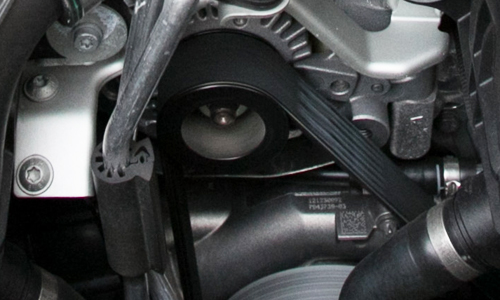An accessory belt that can be found on all vehicles drives the alternator, air-conditioning compressor, and perhaps the power steering and water pump. Since this belt is normally fitted externally, you can see it on the front end of the engine. And it is generally a serpentine belt that slithers around various pulleys. When it displays wear signs like cracks, fraying or stretching, it’s time to get a new one.
Some engines also have a timing belt that is hidden from view but connects the crankshaft on the bottom of the engine to the cylinder head on the top; it controls when valves open and close. Many engines have a timing chain instead of a belt. A key difference is a timing chain is usually considered a lifetime part that doesn’t require periodic replacement. A timing belt does require replacement, though the manufacturer’s maintenance schedule may not call for that until as much as 150,000 miles, as on some current Ford engines.
If either belt breaks, a vehicle is going to soon come to a halt. Once a timing belt breaks, the engine shuts off and you won’t be able to restart it. With many vehicles, you might be able to restart the engine after an accessory drive belt breaks, but you won’t get far if it drives the alternator. Without the alternator, you will be relying on electrical power from the battery, and once that’s gone you will be out of luck.
Though accessory belts can last more than 100,000 miles, they should be inspected by a mechanic periodically (if you know what to look for you can do this yourself). Consult your owner’s manual or service schedule to find out how frequently it should be inspected; this varies by manufacturer. Hyundai says on some current four-cylinders this should be done after six years or 60,000 miles and then every two years or 15,000 miles. Volkswagen calls for it every 40,000 miles, but on some Ford engines it isn’t until 100,000 miles.
Replacement costs also vary, and we’ve seen estimates from less than $75 to more than $150. The best approach is to have it inspected before the recommended interval, and if you decide to have it replaced you will have time to shop around. You may hear warning signals that an accessory belt is on its last legs such as squealing noises when you start the engine or accelerate, or rattling noises from a pulley or tensioner.
Replacing a timing belt is a more involved and costly procedure, typically running from at least $500 to more than $1,000, depending on vehicle. Even worse, on some engines if the timing belt breaks, the pistons may continue to move up and down, and in the process bend valves that have lost their timing mechanism. That can add up to big bucks, possibly $3,000 or more.
That makes timing belt replacement more critical, but because it is not visible you can’t easily check it. That involves removing the accessory drive belts, the engine cover and other hardware just to get a look at it, and no repair shop is going to do this for nothing (they also have to reassemble everything). That is why you should pay close attention to the manufacturer’s recommended replacement schedule. Here, too, recommendations vary. Some Honda V-6 engines call for timing belt replacement at 60,000 miles, for example, but the 1.8-liter four-cylinder used in some Chevrolets lists it at 100,000 miles.
With some engines, the timing belt also drives the water pump, so repair shops may recommend that the water pump be replaced at the same time as the belt. That makes sense because if the water pump breaks a few months after the timing belt is replaced, a mechanic is going to have to go back in there, disassemble everything, replace the coolant and charge you at least a few more hours of labor — again.
In both cases, these belts can and do fail prematurely. The key is to not wait too long to replace either belt because you could wind up stranded and at least be inconvenienced, if not forced, to shell out more money.

Do Vehicles Have More Than One Belt That Needs Changing?
by
Tags:
